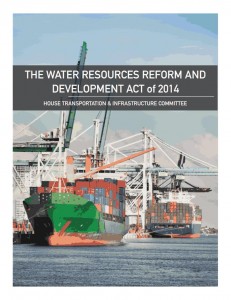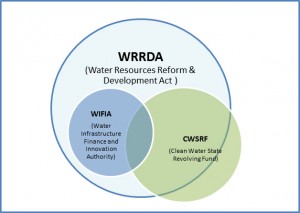
As the federal government considered introducing a new program, the Water Infrastructure Finance and Innovation Authority (WIFIA), for funding water infrastructure projects, some opponents saw the new program as unnecessary. The protest was not centered on a lack of need of financing for water infrastructure. Indeed, the estimated range of need from $122 billion to $3.6 trillion is large enough to warrant action whether you subscribe to the lower end or the higher end of the range! Instead, some saw the existing State Revolving Fund (SRF) program as the most viable vehicle for delivering more financing. Why create a new program when one already exists? At the same time, critics of the existing SRF program pointed to the fact that it was not broad and flexible enough, and had not been significantly updated since 1987. In a surprising turn of events, a bipartisan team of lawmakers addressed both sets of concern in one fell swoop.
WRRDA
H.R. 3080, or the Water Resources Reform & Development Act of 2014, was introduced on September 11th, 2013, and was signed into Public Law 113-121 on June 10th, 2014. WRRDA comes out of the Transportation and Infrastructure Committee. Therefore, transportation projects, such as ports, receive a lot of coverage in the overall document. One example was the controversial Savannah Harbor Expansion Project (SHEP) which applauded the signing of the bill as the last step in allowing the harbor deepening project to “proceed to construction.” The Boston Harbor and restoration in the Everglades were other high-profile projects among the thirty four (34) water infrastructure projects authorized in the document. To be specific, WRRDA authorized these projects that had completed the technical review by the Corps of Engineers (Corps). Another overarching provision of WRRDA is that it reduces this “technical review” time for projects. To address concerns over fifteen (15) year-long feasibility studies, the WRRDA limits review to three (3) years and also caps the budget for these types of studies.
Beyond the thirty four (34) projects already reviewed, WRRDA sets up major changes in the way future water infrastructure projects can be financed. Title V of WRRDA significantly amends the Clean Water SRF program, and creates the new WIFIA funding program. To help keep these acronyms and programs straight, see the Venn diagram in Figure 2.

Clean Water State Revolving Fund Amendments
Title V (around page 130 of the 182-page document) first addresses the existing Clean Water SRF program. Here it amends the Federal Water Pollution Control Act and the Clean Water SRF program. The key changes to this program are highlighted in the list below:
- The repayment period of CWSRF loans is extended from twenty (20) years to up to thirty (30) years, (provided the useful life of the project is up to 30 years)
- There is an allowance for additional subsidization (principal forgiveness or negative interest loans) for “hardship” communities
- Each state is responsible for establishing “affordability criteria” to identify the above “hardship” communities by 09/30/15
- There was an expansion of eligible SRF funding projects to include:
- More non-point source projects: implementation of watershed plans and stormwater recapture
- Energy and water conservation/ efficiency projects related to wastewater treatment plants
- Projects that encourage sustainability
- Technical assistance to small and medium treatment works for planning, design and preconstruction
- Grants are now an allowable form of additional subsidy
- Additional subsidy is available both to “hardship” communities as well as for certain project types (stormwater, energy and water efficiency, sustainable project planning, design, and construction)
Some of these aren’t exactly “new” to the SRF program. Water and energy efficiency and stormwater management were heavily targeted “green” projects by the EPA with the 2009 ARRA components of the SRF program. In fact, in a nineteen-state study, American Rivers found that 38% of all “green project reserve” ARRA funds through the SRF programs went to energy projects – this was much more than other types of “green” water-related projects such as water efficiency and watershed management approaches. However, all of these categories of green projects had only been promoted through less formal “memos” and “guidelines” from EPA. WRRDA is creating some excitement because it codifies these uses of SRF funds, making them a more permanent part of the SRF program than some experts had predicted.
A more genuinely “new” aspect of the CWSRF through WRRDA is the “fiscal sustainability plan” (FSP) that recipients will have to develop and implement. These plans are relevant to projects that involve the repair, replacement, or expansion of a publicly-owned treatment works. (Look for more about FSPs in later blog posts).
WIFIA
After amending the existing SRF program, the WRRDA document goes on to introduce the new Water Infrastructure Finance and Innovation Act (WIFIA) from about page 140. To address the need for infrastructure financing for water projects, WIFIA will provide both the Corps and EPA with $175 million of funding each over the next 5 years.
Due to the high level of water infrastructure need, one of the defining characteristics of WIFIA is that it seeks to encourage public private partnerships, under the idea that public funding alone can’t fill the gap. A project carried out by a private entity is eligible for WIFIA financing, but the project must be publicly sponsored, and the local public agency must support the project. Otherwise, the list of main eligibility criteria for WIFIA reads pretty similarly to eligibility criteria for applicants of CWSRF loans. The size of projects funded through the two programs differs substantially though. For WIFIA, the minimum would be a $20 million project cost. An exception is made for communities of less than 25,000 in population where the minimum would be $5 million. Another caveat geared to smaller communities is that 15% of the $175 million is set aside for small community projects. However, on June 1st of each fiscal year, unspent funds in this set-aside are released for use by larger communities. With the higher loan amounts under WIFIA come a few more financial qualifiers related to creditworthiness and rating opinion letters. Since this is largely a pilot program in these first five (5) years, preference will be given to projects that, among other things, include private financing, are innovative, and are shovel ready. The American Iron and Steel requirement of WIFIA may have some effects on shovel readiness.
In general, WIFIA can only finance up to 49% of a total project, again creating room for private funding. This may also leave room for SRF co-funding, but the total federally-backed financing cannot exceed 80% of total project cost. WIFIA does include a ban on tax-exempt financing of a project receiving WIFIA credit assistance, perhaps partially another attempt to control the proportion of federal funding in a given WIFIA project. Concerns over some of these criteria led to the allowance for 25% of appropriated WIFIA funding to be used to make loans in excess of this 49% threshold of project costs. Also, WIFIA loan terms can essentially extend up to 35 years.
The Interplay between CWSRF and WIFIA
The gray area in the Venn diagram in Figure 2 may be metaphorical too, since there are bound to be some areas of uncertainty as these two federal programs, the Corps and EPA, collaborate on WIFIA. Furthermore, even on the EPA’s own SRF program, the agency will now have to interact with the Corps on some projects going forward. WRRDA addressed the concern of WIFIA being in too much competition with the SRF program by giving the SRF “right-of-first-refusal.” So, WIFIA applications must be shared with the Clean Water SRF, and WIFIA can only fund projects that the SRF refuses to fund (at comparable rates). Sharing applications with the SRF needs to occur within 30 days of receiving the WIFIA application, and the SRF program in turn has a 60-day window to decide if it will fund the project.
Initial Advice for Potential Applicants
Recommendations right now seem to be that an applicant should apply to the CWSRF first, then WIFIA if it is turned down by the SRF program. The reason for this is not only the “right-of-first-refusal” of the SRF program, but also because the EPA portion of WIFIA is predicted to start up before the Corps side of the program, based on EPA’s long experience with running a similar program. For the Corps, this is fairly new territory and so it may take longer to get their program set-up.
Finally, while authorization has occurred via WRRDA, the issue of allocation still looms. Even though the authority now exists, the federal government still needs to act to actually appropriate dollars (i.e. fund) the WIFIA program. This remains an area of anxiety. After all, what prompted both WIFIA and CWSRF reauthorization in one bill in the first place was concern that the new pilot program would allow appropriators to divert funds from the SRFs. While we wait to see how this will play out, maybe you have a prediction. Feel free to share your opinions below.


One Response to “WRRDA: Creating Interactions between the New WIFIA Program and the Updated Clean Water State Revolving Fund”
Stacey Berahzer
Please note that the title and text of this blog have been edited from the original post to reflect some feedback from EPA. The feedback was that WRRDA does not reauthorize the CWSRF. It only includes amendments to the program.